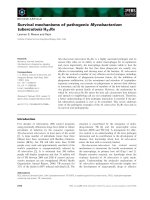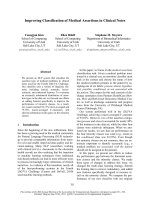Báo cáo khoa học: "Good Spelling of Vietnamese Texts, one aspect of computational linguistics in Vietnam" ppt
Bạn đang xem bản rút gọn của tài liệu. Xem và tải ngay bản đầy đủ của tài liệu tại đây (14.26 KB, 2 trang )
Good Spelling of Vietnamese Texts,
one aspect of computational linguistics in Vietnam
PHAN Huy Khanh
Department of Information Technology
DaNang University
17, Le Duan Street, DaNang City, Vietnam
Abstract
There are many challenging problems for
Vietnamese language processing. It will be a
long time before these challenges are met. Even
some apparently simple problems such as
spelling correction are quite difficult and have
not been approached systematically yet. In this
paper, we will discuss one aspect of this type of
work: designing the so-called Vietools to detect
and correct spelling of Vietnamese texts by
using a spelling database based on TELEX
code. Vietools is also extended to serve many
purposes in Vietnamese language processing.
Introduction
For the past two decades computational
linguistics (CL) has progressed substantially in
Vietnam, mainly in these basic aspects: data
acquisition from the keyboard, encoding, and
restitution through an output device for
Vietnamese diacritic characters, updates on the
fonts in Microsoft DOS/Windows,
standardization for Vietnamese (James Do, Ngo
Thanh Nhan), automatic translation of English
documents into Vietnamese and vice versa (Phan
Thi Tuoi, Dinh Dien), recognition of
handwriting (Hoang Kiem, Nguyen Van
Khuong), speech processing (Nguyen Thanh
Phuc, Quach Tuan Ngoc), building bilingual
dictionaries such as English-Vietnamese and V-
E, French-Vietnamese and V-F dictionaries
(Lac Viet), archives of old Sino-Vietnamese
documents (Ngo Trung Viet, Cong Tam), etc.
Some of these works have been presented in
Informatics and IT workshops organized in
Vietnam. These efforts are modest and do not yet
show our full potential. There are many reasons
for this weakness. The major reasons that
the different efforts are quite isolated and
there is not enough coordination. Some
coordinated workshops held from time to
time would be very helpful.
At the IT Dept. DaNang University we are
building a lexical database based on TELEX
code for accomplishing the following tasks:
- Converting Vietnamese texts from any
font to any other font.
- Putting texts in alphabetical order
independently of the font in use.
- Looking up words up in the monolingual
and / or multilingual dictionary.
- Building specialized monolingual
dictionaries.
At present, we are taking part in the GETA,
CLIPS, IMAG, France, in the FEV project: for
a multilingual dictionary: French-Vietnamese
via English.
In fact, inputting Vietnamese texts still
encounters many problems, not yet solved
properly. The most common mistakes in
detecting and correcting spelling errors are:
- wrong intonation or misspelling,
- not following spelling specialization, not
using syllables systematically in the same
texts, etc.
Winword, a commercial text processor, is not
able to detect and correct spelling mistakes.
The program designed by Ngo Thanh Nhan
(without an associated spelling dictionary)
and other software packages for Vietnamese
still do not offer adequate solutions.
We propose here a general solution for
building the so-called Vietools for detecting
and correcting spelling errors. Vietools is
designed for office application such as
Winword, Excel, Acess, PowerPoint, etc. in
Microsoft Windows. Vietools has also been
extended for converting and rearranging
Vietnamese words in the dictionaries and
consulting the Vietnamese dictionaries,
including multilingual dictionaries.
1 Building spelling database
In the spelling dictionary by Hoang Phe
(1995), there are 6760 syllables in the writing
system (6616 syllables in the phonology
system) to compose single words or complex
words. Each syllable has two parts: initial
consonant (optional) and rhyme pattern
(including rhyme and tone). Altogether, there
are 27 initial consonants, and 1160 rhyme
patterns (including 6 tones).
Based on Vietnamese syllable structure, the
spelling database is built in a tabular form. Each
element of the table helps to check the
correction of a syllable based on the column
position of initial consonants and the row
position of rhyme patterns, for example, the
syllable lamf (work) in the TELEX form, is
composed of the initial consonant l and
rhyme pattern am with by low falling tone
(or grave accent) f. Each element of the table
can be understood as:
- syllables used in Vietnamese.
- elements between tone sign positions (on
o: oja or on a: oaj), pronunciation or
dialect with spelling (z is equivalent to d
or gi, y is equivalent to i ) and
borrowings such as karaoke, photocopy,
fax
- Sino-Vietnamese word: coongj (addition)
→ congj, quoocs (country) → nuwowcs
- being unable to form syllables: quts,
quoon, coan , cuee
Techniques have been developed to
recognize the compound words from two
syllables, such as baor damr or damr baor
(guarantee), chung chung (vague), etc., from
three syllables, such as howpj tacs xax
(cooperative), etc., from four syllables, such
as coong awn vieecj lamf (work, job), etc.
2 Designing Vietools
The error detecting program reads one syllable at
a time from the text. The syllable is divided into
an initial consonant and a rhyme pattern, paying
attention to solving initial consonants such as: gi
containing vowel i; the consonant qu has vowel u,
but it is easy to separate it from the syllable for it
does not have the consonant q; the other
combined initial consonants have the length of 2,
or 3. The error-correcting unit checks the
conformity of initial consonants (if present) and
the rhyme pattern.
3 Code converting
At present, there are many Vietnamese fonts
built on different codes (different in number
of bytes used: 1 byte or 2 bytes, order of
tones, letter arrangements, etc.). Because
there has not been a unified code for
Vietnamese text, we selected a pivot code
and TELEX code. There are many codes to
convert from such as IBM-CP01129,
Microsoft-CP1258, VISCII, VietKey,
VietWare, VNI, TCVN3, Unicode, etc.
Vietools works on syllables converted to
TELEX. Vietools analyses syllables to
detect initial consonants and rhyme pattern
in TELEX code.
Conclusion
The main advantage of our method is that
the tool operates independently of the
Vietnamese font used. The design of
Vietools is open: one can add new functions
such as text or data conversion Spelling data
base structure design helps building multi-
functional dictionaries, which are essential
for natural language processing.
Acknowledgements
My thanks go to my students for the
realization of Vietools and my colleagues for
their opinions. In particular, I thank Professor
Aravind Joshi, University of Pennsylvania,
Philadelphia, USA, for his helpful suggestions
I am grateful to Christian Boitet, Professor,
Joseph Fourier University, GETA, CLIPS,
IMAG, France, for his comments on this
paper.
References
1. Hoang Phe (1995) Dictionary of Orthography.
Center of Lexicography, DaNang Publishing
House, 509 p.
2. Hoang Phe (1997) Vietnamese Dictionary.
Center of Lexicography, DaNang Publishing
House, 1130 p.









